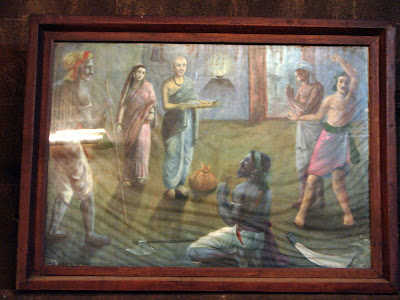
Gumbaz Museum
It was 8:30AM and we had spent sufficient time at the Gumbaz. We had to only visit the museum and that was to open at 10:00AM. We had sufficient time to eat our breakfast. After eating the dinner at our hotel restaurant the previous evening we were sure we didn't want to eat there again. I remembered from my previous visit to the Gumbaz that there was a small canteen in the premises. We strolled in the garden for a while and then went to the canteen.


It is a small place with a seating capacity of at most 6 people. Small wooden benches and a few rusty chairs form the complete set of furniture in the canteen. I opted to have "
avalakki" (beaten rice) and the others opted to have upma. After the miserable dinner the previous night, the breakfast tasted really delicious. I ordered for KT -- this tea is prepared with a generous amount of milk and is also flavoured with elaichi. The previous evening we had tea in the hotel restaurant that tasted not just
yuck , but also smelled bad. I am almost certain that it was prepared with Goat's milk. V felt repulsive after I revealed the secret of the bad tasting tea :). U reminded him that Goat's milk was good for health and
Bapuji had Goat's milk everyday :). I guess only Gandhiji can drink this milk :) and I didn't finish my tea. I'm not sure if V drank it either :).
While we were relishing the tea, we saw another family (a man, two women and a little girl, perhaps there were more people and I didn't notice them) who came to the canteen. They wanted to eat idlis :) but the canteen didn't serve any. I am not sure what they had for breakfast, but what I am certain about is the fact that they didn't know anything about
cleanliness . They sat on the grass in the garden and had their breakfast. When they left the canteen, we noticed that they had strewn food on the grass :(. The little buss boy didn't clean the garden after them either.

We had to return to the hotel, freshen up and then return to the museum. The hotel supplied hot water in the rooms only between 6 and 9 in the morning. Though it was well past 6:30 AM when we left the hotel room in the morning, the water in the shower wasn't hot. We felt it would be a good idea to visit the Gumbaz and then return to the hotel, shower and then visit the museum. We had to check out of the hotel at 10:00AM and so we vacated the rooms after we had showered. We stored our bags in the hotel reception area and went to the museum.


Jain Yakshini
The museum located in the Naqquar Khana (Trumpet House) of the Gol Gumbaz Complex, was originally established as a district museum in 1892. Later on it was taken over to develop it as a site museum in 1982. Naqquar Khana is in typical Adilshahi architectural style and has elevated platforms and tall and loft arches raised over massive piers. The large and good massive showcases introduced by the British officers, themselves have become good examples of antique furniture.
The collection comprises of stone inscriptions of Arabic, Persian, Kannada and Sanskrit languages in different scripts and written in varied calligraphy, Brahmanical and Jaina sculptures, hero stones, illustrated and plain manuscripts, coins, China wares, wooden carving, carpets, maps, sanads and firmans, miniature pantings, Bidiri ware and other house hold articles, datable from 6th to 18th century AD.
The museum has six galleries, three in the ground floor and the rest in upper story. It houses a majority of movable cultural property of the region with a special collection of Adilshahi art objects.
The first gallery displays Brahmanical sculptures and second gallery has Jain sculptures. Third gallery displays inscriptions of Arabic, Persian, Sanskrit and Kannada languages with a variety of calligraphy. Fourth gallery exhibits arms, weapons and other metal wares. Fifth gallery has miniature painting, carpets, smaller metal objects. Sixth gallery exhibits Arabic and Persian manuscript, China porcelain wares etc. Inscribed slabs depicting excellent calligraphy, illustrated manuscripts of the Holy Quran, arms and weapons, well attired torso of a royal person, photo enlargements of excellent specimens of Adilshahi miniatures, translides of kings and queens and world’s famous monuments comparable with Gol Gumbaz are the main attractions in the museum.

...en bek mallayya...
After visiting the museum we went back to the garden and sat under the shade of a huge tree. A lot of school children were visiting the monument that Sunday morning. A group of little children were playing underneath the tree where we were seated. It reminded us of our school days when we used to play the very game but probaby sing a different song while playing. The kids were singing something that goes like...
"something something, en bek mallayya..."V, post your comment with the song that you sang while playing this game...






























